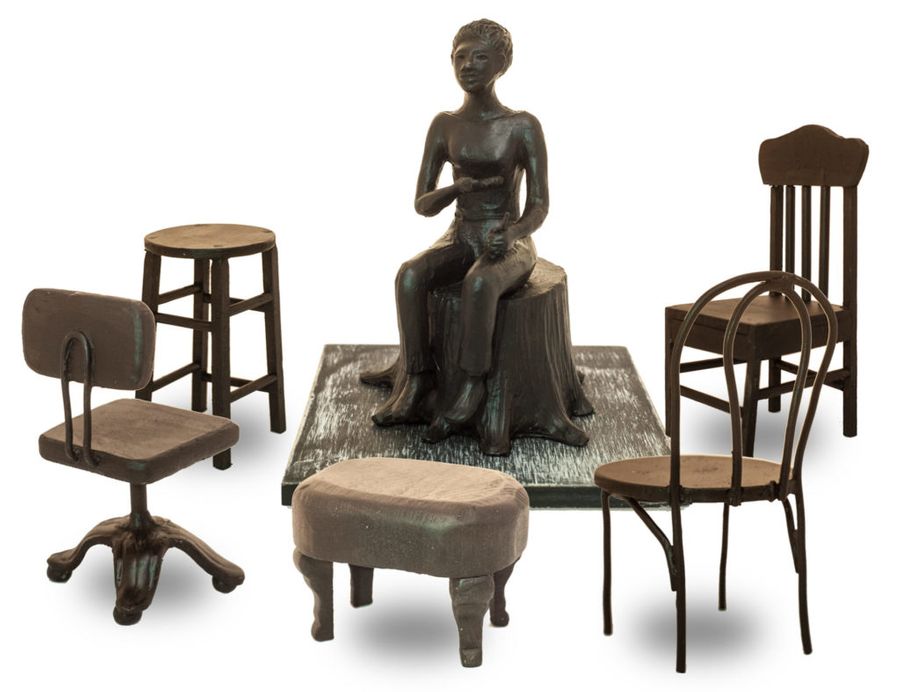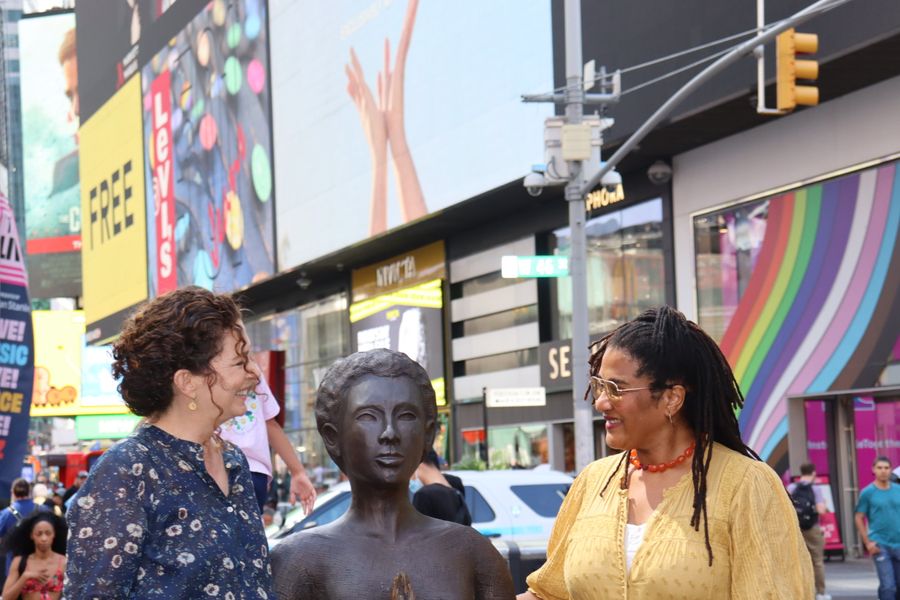“Just sit a while and think. Never be afraid to sit a while and think.”
Over time, this moment, plucked from the third act of Lorraine Hansberry’s seminal play A Raisin in the Sun, has morphed into a commonly shared motto, an inspiring meditative practice, and now, a new sculpture.
On June 9, a bronzed figure of Lorraine Hansberry titled “To Sit A While” was unveiled in Times Square before an audience of friends, admirers, and family. The piece was carved by California-based artist Alison Saar and commissioned by the Lillys, an organization that has celebrated, awarded, and advocated for women theatre artists since its founding in 2010. Fundraising for the Lorraine Hansberry Initiative (LHI) began prior to the COVID-19 pandemic and continues today.
Spearheading the work is Lillys executive director Julia Jordan and board member/history-shattering playwright in her own right, Lynn Nottage, with contributions from titans like Dominique Morisseau, Charlayne Woodard, and LaTanya Richardson Jackson. I was fortunate enough to attend the unveiling on that tentatively warm New York Thursday and bear witness to their labor of love. According to Jordan, also a theatremaker when she’s not busy championing her peers, this effort is “the most important work of my life.”
Although it was by no means the beginning nor the end of Hansberry’s triumphs, we have to talk about A Raisin in the Sun. The drama centers on the Younger family of Chicago’s South Side, loosely based on Lorraine’s own, and their pursuit of upward financial and social mobility in the face of racial prejudice. Its debut in 1959 cemented her in history as the first Black woman to have a play on Broadway. More than 60 years later, it remains a staple of the American literary canon, our education system, and regional productions. A quick Google search revealed recent productions at the Guthrie, Chesapeake Shakespeare Company, and Olney Theater Center, as well as upcoming ones at American Players Theater and New York’s Public Theater.
“We didn’t choose to honor Lorraine because she was a Black female playwright. We chose to honor her because she is the most important female playwright, arguably the most important American playwright. She just is. She wrote the most important American play.”
On that June day, the buzzing excitement of the crowd, just feet away from midtown’s signature red TKTS steps, further embodied the indelible impact of Lorraine’s legacy. A collection of popular playwrights, actors, and established artistic directors stood aside college students, writing assistants, and fresh faces to the industry, all giddy for a glimpse of the iron lady. Introductory speeches from Jordan and Nottage, a tear-inducing rendition of Lynn Ahrens and Stephen Flaherty’s “The Human Heart” by LaChanze, and an emotional tribute from Taye Hansberry, Lorraine’s great-niece, rounded out the afternoon.
But “To Sit A While” is more than a statue. It was essential to LHI that it would raise public awareness of the full breadth of Hansberry’s cultural contributions, which go far beyond the Youngers. According to Imani Perry, an interdisciplinary scholar and author of Looking for Lorraine: The Radical and Radiant Life of Lorraine Hansberry, the late playwright “had an unflinching commitment to social justice,” which included “challenging President Kennedy and his brother to take bolder stances on Civil Rights, supporting African anti-colonial leaders, and confronting the romantic racism of the Beat poets and Village hipsters. Though she married a man, she identified as lesbian and, risking censure and the prospect of being outed, joined one of the nation’s first lesbian organizations.”
James Baldwin, Nina Simone, Paul Robeson, and Lena Horne weren’t simply her contemporaries—they were co-conspirators striving for Black liberation. The weight of this overarching but underreported political history is etched into Saar’s work. Five seats form a circle around the steel scribe, representing core aspects of her livelihood: the modernist chair, an emblem of where Lorraine sat and wrote, and an office chair representing her journalistic contributions, specifically to Freedom, the African American newspaper founded by Paul Robeson and W.E.B Du Bois. A stool stands for her contributions as a champion of feminist and LGBTQ+ rights; the ottoman is a talisman from a famous Baldwin-Kennedy meeting, in which Lorraine played an essential part; and the bentwood chair is meant to give a sense of her domestic life.
Technically, there is a sixth seat: the stump that Lorraine is perched on, holding an eternal flame to her heart. The position of her body was an important one to the creators; it seemed fitting that she take her own advice and sit in communion with her onlookers rather than tower over them.

“We were less concerned about it being a facsimile of Lorraine, but more so a sculpture that really captured her energy and the complexity of her character—one that invites engagement and changes depending on who’s in that circle,” Nottage explained. “Those chairs can be placed in different configurations, and whichever city it goes to gets to have a say.”
As indicated by that last remark, “To Sit A While” didn’t sit at 47th Street for long. Since its unveiling, the sculpture has been presented at Harlem’s Schomburg Center for Research in Black Culture and the Brooklyn Bridge Park, and she’ll next alight in cities all across the nation: Detroit, Washington, D.C., Los Angeles, and Atlanta will host her at HBCUs, theatres, and museums, before she takes her permanent home—where else?—in Chicago.
Where she goes, there will be programming efforts to coincide with each step in her sojourn. One was hosted by New Victory Theater, New York’s theatre for young audiences and families. In a program called “Speak Up, Act Out,” presented in collaboration with the Lillys and 24 Hour Plays, eight children from schools across the boroughs presented original scenes inspired by Hansberry’s activist work. It is not often that I get to hear the concerns of the day from out of the mouths of babes, but here these 10-, 11-, and 12-year-old spirits were, only two weeks after the devastating Uvalde, Texas, school shooting, penning the most affecting dialogue about fear and freedom.
The final component of the initiative is, literally and figuratively, the largest one. A $2.5-million endowment will support scholarships for women and non-binary writers of color in each year of their graduate study. (Actually, the goal is $3.5 million, and donations are still urgently needed and gladly accepted). The fund aims to be a life-altering investment that goes directly into the hands of students, rather than their institution’s, to cover living expenses, the thing, as Nottage tells me, often “breaks people.” Clearly passionate even over the phone, she goes on to say, “It’s impossible to be a full-time student, work, and make enough money to survive, particularly if you’re going to a school in a city. We wanted to alleviate some of that burden so that women and non-binary writers could fully focus on their voices and not be concerned with how they’re going to eat or where they’re going to live, so that they don’t have that extra layer of anxiety which is just not conducive to being creative.”
The fund was not the original mission of LHI (a new-play commission was considered instead), but Jordan tells me she feels the organization’s decision was the right one. It allows for Hansberry’s impact to “go forward, as well as back.”
Brittani Samuel (she/her) is a New York-based writer, critic, and co-editor of 3Views on Theater. Bylines can be found at places like Observer, Glamour, OkayAfrica, and InStyle. She can be found at BrittaniSamuel.com or on Instagram at @brittaniidiannee.


